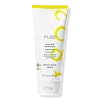What's inside
What's inside
 Key Ingredients
Key Ingredients

 Benefits
Benefits

 Concerns
Concerns

 Ingredients Side-by-side
Ingredients Side-by-side

Water
Skin ConditioningGlycerin
HumectantGlyceryl Stearate
EmollientIsopropyl Palmitate
EmollientCetearyl Alcohol
EmollientCetyl Alcohol
EmollientButyrospermum Parkii Butter
Skin ConditioningCaprae Lac
Skin ConditioningSimmondsia Chinensis Seed Oil
EmollientC13-15 Alkane
SolventCaprylyl Glycol
EmollientCaprylic/Capric Triglyceride
MaskingCarbomer
Emulsion StabilisingCaprylhydroxamic Acid
Panthenol
Skin ConditioningSodium Hydroxide
BufferingSodium Ascorbyl Phosphate
AntioxidantWater, Glycerin, Glyceryl Stearate, Isopropyl Palmitate, Cetearyl Alcohol, Cetyl Alcohol, Butyrospermum Parkii Butter, Caprae Lac, Simmondsia Chinensis Seed Oil, C13-15 Alkane, Caprylyl Glycol, Caprylic/Capric Triglyceride, Carbomer, Caprylhydroxamic Acid, Panthenol, Sodium Hydroxide, Sodium Ascorbyl Phosphate
Water
Skin ConditioningGlycerin
HumectantSqualane
EmollientButylene Glycol
HumectantPentylene Glycol
Skin ConditioningJojoba Esters
EmollientCetearyl Alcohol
EmollientHydrogenated Coco-Glycerides
EmollientOctyldodecanol
EmollientOlus Oil
EmollientHydroxyethyl Acrylate/Sodium Acryloyldimethyl Taurate Copolymer
Emulsion StabilisingIrvingia Gabonensis Kernel Butter
Skin ConditioningEuphorbia Cerifera Wax
Olea Europaea Fruit Oil
MaskingCentella Asiatica Extract
CleansingLinum Usitatissimum Seed Extract
PerfumingHydrolyzed Rice Bran Protein
Skin ConditioningLinum Usitatissimum Seed Oil
PerfumingHydrogenated Vegetable Oil
EmollientNiacinamide
SmoothingBiotin
AntiseborrhoeicCetearyl Glucoside
EmulsifyingBehenyl Alcohol
EmollientSodium Stearoyl Glutamate
CleansingCaprylyl Glycol
EmollientSodium Hyaluronate
HumectantPolysorbate 60
EmulsifyingSorbitan Isostearate
EmulsifyingCitric Acid
BufferingSodium Citrate
BufferingParfum
MaskingXanthan Gum
EmulsifyingTocopherol
AntioxidantSodium Hydroxide
BufferingChlorphenesin
AntimicrobialSodium Benzoate
MaskingSorbic Acid
PreservativeWater, Glycerin, Squalane, Butylene Glycol, Pentylene Glycol, Jojoba Esters, Cetearyl Alcohol, Hydrogenated Coco-Glycerides, Octyldodecanol, Olus Oil, Hydroxyethyl Acrylate/Sodium Acryloyldimethyl Taurate Copolymer, Irvingia Gabonensis Kernel Butter, Euphorbia Cerifera Wax, Olea Europaea Fruit Oil, Centella Asiatica Extract, Linum Usitatissimum Seed Extract, Hydrolyzed Rice Bran Protein, Linum Usitatissimum Seed Oil, Hydrogenated Vegetable Oil, Niacinamide, Biotin, Cetearyl Glucoside, Behenyl Alcohol, Sodium Stearoyl Glutamate, Caprylyl Glycol, Sodium Hyaluronate, Polysorbate 60, Sorbitan Isostearate, Citric Acid, Sodium Citrate, Parfum, Xanthan Gum, Tocopherol, Sodium Hydroxide, Chlorphenesin, Sodium Benzoate, Sorbic Acid
Ingredients Explained
These ingredients are found in both products.
Ingredients higher up in an ingredient list are typically present in a larger amount.
Caprylyl Glycol is a humectant and emollient, meaning it attracts and preserves moisture.
It is a common ingredient in many products, especially those designed to hydrate skin. The primary benefits are retaining moisture, skin softening, and promoting a healthy skin barrier.
Though Caprylyl Glycol is an alcohol derived from fatty acids, it is not the kind that can dry out skin.
This ingredient is also used as a preservative to extend the life of products. It has slight antimicrobial properties.
Learn more about Caprylyl GlycolCetearyl alcohol is a mixture of two fatty alcohols: cetyl alcohol and stearyl alcohol. It is mainly used as an emulsifier. Emulsifiers help prevent the separation of oils and products. Due to its composition, it can also be used to thicken a product or help create foam.
Cetearyl alcohol is an emollient. Emollients help soothe and hydrate the skin by trapping moisture.
Studies show Cetearyl alcohol is non-toxic and non-irritating. The FDA allows products labeled "alcohol-free" to have fatty alcohols.
This ingredient is usually derived from plant oils such as palm, vegetable, or coconut oils. There is debate on whether this ingredient will cause acne.
Due to the fatty acid base, this ingredient may not be Malassezia folliculitis safe.
Learn more about Cetearyl AlcoholGlycerin is already naturally found in your skin. It helps moisturize and protect your skin.
A study from 2016 found glycerin to be more effective as a humectant than AHAs and hyaluronic acid.
As a humectant, it helps the skin stay hydrated by pulling moisture to your skin. The low molecular weight of glycerin allows it to pull moisture into the deeper layers of your skin.
Hydrated skin improves your skin barrier; Your skin barrier helps protect against irritants and bacteria.
Glycerin has also been found to have antimicrobial and antiviral properties. Due to these properties, glycerin is often used in wound and burn treatments.
In cosmetics, glycerin is usually derived from plants such as soybean or palm. However, it can also be sourced from animals, such as tallow or animal fat.
This ingredient is organic, colorless, odorless, and non-toxic.
Glycerin is the name for this ingredient in American English. British English uses Glycerol/Glycerine.
Learn more about GlycerinSodium Hydroxide is also known as lye or caustic soda. It is used to adjust the pH of products; many ingredients require a specific pH to be effective.
In small amounts, sodium hydroxide is considered safe to use. However, large amounts may cause chemical burns due to its high alkaline.
Your skin has a natural pH and acid mantle. This acid mantle helps prevent harmful bacteria from breaking through. The acid mantle also helps keep your skin hydrated.
"Alkaline" refers to a high pH level. A low pH level would be considered acidic.
Learn more about Sodium HydroxideWater. It's the most common cosmetic ingredient of all. You'll usually see it at the top of ingredient lists, meaning that it makes up the largest part of the product.
So why is it so popular? Water most often acts as a solvent - this means that it helps dissolve other ingredients into the formulation.
You'll also recognize water as that liquid we all need to stay alive. If you see this, drink a glass of water. Stay hydrated!
Learn more about Water